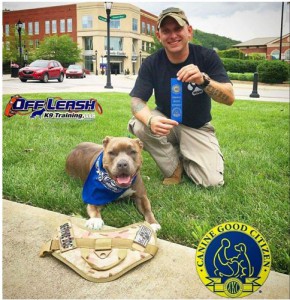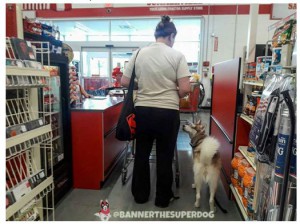Written by: Emily Schooling, Independent Living Advocate at Placer Independent Resource Services
September is Service Dog Month! In honor of all service animals, we’re sharing 10 tips that will help you separate fact from fiction.
- There are three different kinds of support animals.

- Service dogs are task trained to assist handlers with disabilities so the handlers can lead more independent lives. Only service dogs are protected under the Americans with Disabilities Act (ADA) and must be allowed in public places such as restaurants, grocery stores and on public transportation.
- Emotional Support Dogs or Companion Dogs provide emotional comfort to their owners with disabilities but do not require any extra training. Emotional support animals are protected under the Fair Housing Amendments Act (FHAA). Landlords can request that tenants obtain documentation from their doctor that they have a disability and their well-being benefits from having an emotional support animal. It can be as simple as a note written on a prescription pad that you benefit from the presence of the animal.
- Therapy dogs provide comfort to many people in a variety of settings such as schools, hospitals, nursing homes and more. Therapy dogs are not protected under either the ADA or the FHAA and their access is at the discretion of business owners or managers.
- There is NO certification for a service dog.
- Under the ADA there is no certification required for a service dog. The differences between a service dog and a non-service dog are very apparent. Service dogs may be trained professionally or by their owners to learn how to assist disabled handlers. They must do at least one specifically trained task to assist their owner or disabled handler and be well behaved in public in order to mitigate the impact of that person’s disability. They are essentially medical equipment, such as when a person needs an oxygen tank, a cane, a hearing aid, blood sugar monitor, etc.
- Service dogs do not have to wear a vest or any other kind of identification.
- A common misconception is that service dogs have to wear identification such as a vest. This is not required under the ADA. However, many handlers choose to use a vest because it makes access easier.
- There is no breed or weight restriction to a service dog.
- Any size or breed of dog can be a service dog. Some dogs are more appropriate for tasks than others. For example, it is not practical for a Chihuahua to pull a wheelchair but they might be able to serve as an alert dog for allergens in food or a hearing alert dog that lets their hearing-impaired owner know when the doorbell or phone rings. Although we typically see Labs, Golden Retrievers and German Shepherds, many other breeds make wonderful service dogs. Check out Roxy the PTSD Service Dog, and Banner, Super Hero Service Dog on Facebook!
- Fake Service Dogs are a public safety risk!
- As we learn about the incredible things service dogs can do and they become more visible, we also learn about the challenges that face our community in the form of fake service dogs. If you do not have a disability and if your dog is not task trained, it is NOT a service dog. Fake service dogs pose a great threat to the disabled community and to the public. They can distract or attack a real service dog team causing injury or death to the handler or their service dog. They damage public trust in legitimate service dog teams, and they can physically injure other members of the public. Service dog fraud is a federal crime and is punishable by fine. You may be held liable if your dog causes an injury to someone else if you presented your dog as a service animal when it is not. Having a service dog is not a convenience so that people can take their dog with them everywhere they go. A service dog is a tool that a disabled person uses to be independent where they otherwise could not be!
- The best thing you can do when you see a service dog is to ignore it.
- When you are trying to work would it be distracting if people were trying to touch you, whistle or blow kisses at you? What if someone’s life depended on your ability to work and someone else did this? That is a reality that many service dog teams face. If you see a service dog, ignore it! No matter how cute the dog is, let the dog do their job.
- There are only two questions that businesses and public entities can ask.
- Is this a service dog that is required because of a disability?
- What tasks is the dog trained to do? They may not ask about the nature of the disability or request proof or documentation. The dog must perform at least one specifically trained task that assists a person with one or more major life activities that is limited due to their disability.
- Businesses and other public places are allowed to ask that a service dog be removed in certain situations.
- A service dog must be well behaved in a public location and under the handler’s control at all times. Service dogs must be parasite and odor free as well. If they are posing a threat
to safety with growling, biting, lunging or jumping, or if they are relieving themselves inside a business such as a grocery store, then management can ask them to leave. If the dog is removed for one of these reasons, the business is still required to offer services to the disabled person without the dog present. Banner, Superhero Service Dog’s mom says: “Service dogs do not sit at tables or on tables in restaurants unless they are pet friendly, and service dogs do not belong in grocery store carts. If the establishment sells food, it is considered a health hazard.” She also says, “Service dogs do occasionally make errors. The best way to tell them apart from fake service dogs is the owner (handler) will immediately correct the behavior team whereas a fake team doesn’t bother.”
- A service dog must be well behaved in a public location and under the handler’s control at all times. Service dogs must be parasite and odor free as well. If they are posing a threat
- Dogs are the only animal recognized as service animals.
- However, miniature horses are sometimes allowed in certain circumstances as long as the facility can accommodate the miniature horse’s type, size, and weight. They must also perform at least one specifically trained task to assist a disabled owner and are protected under the ADA. Other animals such as cats, reptiles and birds would be considered emotional support animals and are not protected under the ADA.
- Service dogs perform incredible tasks!
- There is an ever- growing number of tasks that a dog can do. There are seeing-eye dogs for the blind and visually impaired; seizure alert dogs; hearing alert dogs; psychiatric service dogs that do tasks such as remind their handler to take their medication or assist their owner during a panic attack and guide them from a crowded room; diabetes alert dogs who alert to drops and spikes in blood sugar; dogs that pull wheelchairs, open doors, alert to allergens in food, and so much more!
More resources:
ADA National Network:
https://adata.org/sites/adata.org/files/files/Service%20Animal_6-18.pdf
https://www.ada.gov/service_animals_2010.htm
Check out on Facebook:






